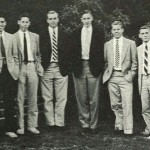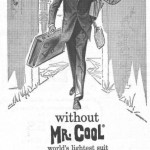 When it comes to starting fashion trends, there’s Princeton and then there’s every other school. From the three-button suit to its namesake haircut, Princeton has popularized such menswear staples as Norfolk jackets, raccoon coats, tweed sport coats, rep ties, spectator shoes, khaki pants and Shetland sweaters.
When it comes to starting fashion trends, there’s Princeton and then there’s every other school. From the three-button suit to its namesake haircut, Princeton has popularized such menswear staples as Norfolk jackets, raccoon coats, tweed sport coats, rep ties, spectator shoes, khaki pants and Shetland sweaters.
Princeton’s sartorial influence has been dulled by time, but for much of the 20th century it was well acknowledged by both a watchful fashion industry and rival schools.
LIFE magazine’s 1938 article, “Princeton Boys Dress in a Uniform,” confirms that “tailors and haberdashers watch Princeton students closely,” while students at Harvard and Yale call Princetonians “the prototype of Hollywood’s conception of how the well-dressed college boy should look.”
So how did Princeton men become such recognized style leaders?
Like most clotheshorses, they had money and a penchant for both quality and quantity. As one student wrote in a 1931 campus publication, “As every Princeton father knows, his son’s clothes are expensive.” Yearbooks, newspapers and athletic programs were filled with advertisements for Brooks Brothers and Franks Brothers, a top-tier shoe company.
Not only did Princeton men spend big bucks on their own apparel, but their stamp of approval helped manufacturers court other collegiates. The school’s name attached to a garment conferred integrity. EE Taylor Corporation’s “Princetonian” shoe was advertised as direct “from the campus of the country’s collegiate fashion center,” and was one of the company’s best selling models of 1934.
Secondly, Princetonians lived in a self-regulated environment with a well defined social pecking order. Sure, Harvard and Yale had their share of insularity and rich white kids, but they also pioneered financial aid and scholarships, which fostered a more diverse student body than Princeton. In rural New Jersey with little meddling from administrators, Princeton men created a homogenous campus culture that prioritized fitting in.
In “This Side of Paradise,” F. Scott Fitzgerald, describing his protagonist’s first day at Princeton, wrote, “Amory felt unnecessarily stiff and awkward among these white-flannelled, bare-headed youths who must be juniors and seniors, judging by the savoir-faire with which they strolled,” and he “wondered vaguely if there was something the matter with his clothes.”
For the first half of the century, Princeton freshmen and sophomores were banned by tradition from wearing particular garments, such as white flannel pants or striped ties. One had to earn the right to dress like a Princeton man.
While an ample bank account and the need to dress the part allowed Princeton students to assemble a well honed wardrobe, the leisure-based lifestyle of their campus inspired the actual trends. Athletics dominated Priceton’s student culture. Sportswear was worn around the clock. Earlier trends, such as tweed golfing suits or flannel blazers, had an air of formality. Those that came later in the century couldn’t have been more casual, and included sweatshirts, sneakers and t-shirts. Despite such differences, the collective contribution of Princeton students to the modern American wardrobe is undeniable. Whether you’re wearing khakis and a sport coat or jeans and a cardigan, chances are your clothes were first popularized at Princeton. — DEIRDRE CLEMENTE










Ms. Clemente-
Very excellent insight. I’m glad you could contribute your talents to this site.
Regards
Not bad. “Rich White Kids” is imprecise, and a bit of a bore.
Christian – do you think you could post a list of prep books, guidance books, or what not that are keys to the lifestyle? ignore the preppy handbook, and Elegance, of course.
Deirdre,
Wonderful contribution. I hope to see more of it in the future. Furthermore, as a graduate of undergrad and law school in the north-east (and thus being privy to the breakdown of fashion habits at various ivy campuses), I appreciate your observations. I’m now curious to hear your opinion on the future of campus fashions, as brands like Rugby, A&F (to a much lesser extent), and others are spearheading a kind of renaissance of this style. I even see much of it in the characters’ wardrobes in Gossip Girl (see Chuck Bass and Blair Waldorf; of course, even the names are indicative of the aesthetic), and other places.
Thanks,
-Fred.
It is also important to remember that Harvard, Yale, Columbia, etc. are located in (large) cities, which influence the fashion choices tremendously. The writer touched on it, but Princeton’s isolated location is what really sets/set it apart.
Princeton was actually the first school in the country to offer grant-based financial aid (as opposed to loans). Only afterward did Harvard and Yale follow suit, and still many students choose Princeton over their HY peers for financial reasons.
What Catherine refers to is a far more recent development, when Princeton replaced aid packages containing some loans with all-grant packages. What’s referred to in the article happened several decades ago; before which there was no appreciable financial aid at all. Times change.
So Miss Clemente’s thrice denial to Princeton is actually part of her resume! Amusing and clever at the same time! Reminds me of an old law school friend who had his Harvard Law rejection letter framed on the wall of his study. Great post.
I doubt very much that Princeton was responsible for everything being claimed here. Khakis? T-shirts? Jeans and cardigans? Sorry, but this is a load of Millennial codswallop.
I’ll echo Annapolis’suggestion of composing a list of ‘guide’ books on Ivy/Prep/Trad style. You may include OPH as an added reference.
elder prep and Annapolis:
Have you heard of Google?
More about Hugh (“Bud”) Wynne, the chap in the top photo:
A Chum from Choate & Old Nassau: Hugh Wynne
A piece of wood on display at the Historical Society of Princeton has special meaning for Hugh de Neufville Wynne. It’s the bannister of the dormitory where John F. Kennedy lived when he was a freshman member of Princeton University Class of 1939.
Wynne had met Kennedy when they were students in prep school, Choate, in Connecticut. “We took a liking to one another and enjoyed hanging around together,” says Wynne, who lives in Princeton with his wife Irene and, for two decades, has been the president of Princeton University Class of ’39.
“Jack was a very optimistic, very happy, cheerful individual, who couldn’t help but impress you. I visited his home in Hyannisport on numerous occasions. The old man was into moving pictures and had in the basement of the house rigged up as an auditorium, so after dinner you would go downstairs and see a movie. I crewed with him, on occasion, sailing to places like Martha’s Vineyard.”
Kennedy, who enrolled at Princeton along with Wynne, became ill and missed most of his freshman year. Wynne says that his friend was pressured by his father and brother, who were Harvard men, to enroll at Harvard. “I kept up the friendship after he moved into the Senate, but we did not go to his wedding — we were living overseas.”
As a geologist with Esso (now Exxon) in Venezuela, Wynne met and married his wife, Irene, in 1941. Wynne had executive positions with Exxon in Argentina, Libya, North Africa, and Spain. As an undergraduate he had been the regimental commander of the ROTC, and, as a reserve officer, he spent World War II in Panama as an aide to one-star and a three-star generals.
By 1963 he was in charge of Esso’s operations in several South American countries and living in Buenos Aires, Argentina. “It was the day I was being transferred to Tripoli, Libya. The Associated Press called me, said he’d been shot. I had my bag packed for the company car to take me to the airport to fly to Tripoli. When they said they didn’t know if he had been killed, I was stunned. They called back and said he was assassinated. That was a terrible shock. I had no choice but to continue with my plans. But it was amazing, wherever we stopped, to see the reaction of the people. In Colombia they were also stunned, and they immediately prepared to memorialize Kennedy with wreaths and flowers.”
As a result of the assassination, some company regulations were changed. “The senior officers were encouraged to not follow the same route to their office. Security was increased. You became more alert to what was going on immediately around you.”
“After the assassination I didn’t answer questions from anybody. I was so affected that I didn’t care to — not until the author of a book, years later, came to see me, and I helped him with a lot of information about Jack.”
“What affected me more than September 11 was Robert Kennedy’s assassination. I thought, `What is this world coming to?’ By the time 9/11 came along it was a whole different scheme.”
16 of Princeton’s 23 founding trustees were slave owners. Maybe some of these’s men’s statues need to be torn down. Or buildings and streets need to be renamed? Let us not contain our indignation to Yale or to the South.
Nice piece from 2009. Always glad to read and comment from the present.
Remember well the guys at Princeton, on the lawns of their eating clubs playing catch with lacrosse sticks. Khakis, Brooks or Gant shirts often blue and of course OCBD. Black boatneck sweaters sometimes with a “Major P”. Almost as Preppy as Lawrenceville, its next door neighbor and chief “feeder” prep school.